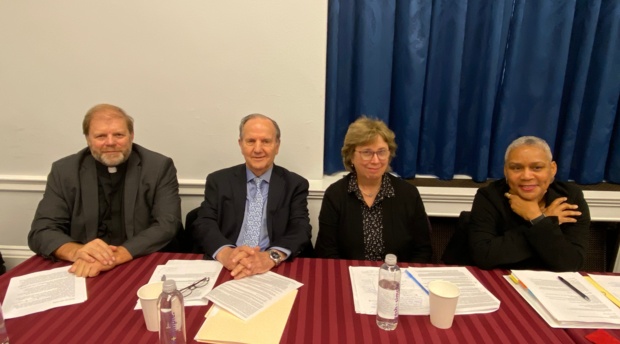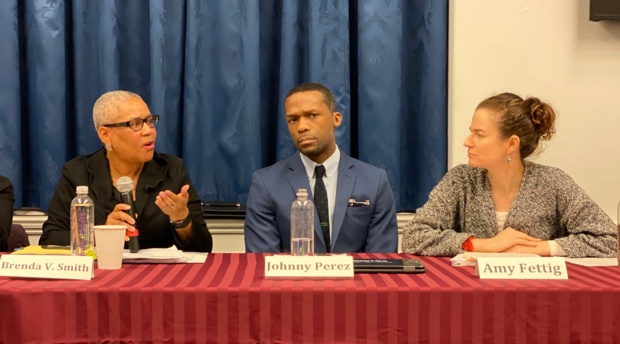AUWCL Experts Address Solitary Confinement Use in U.S. Prisons at Capitol Hill Briefing
Dec. 2, 2019
On Thursday, Nov. 21, Professors Juan Mendez and Brenda Smith headed to Capitol Hill to participate in a congressional staff briefing on “Solitary Confinement: Briefing on H.R. 4488.” This recently introduced legislation focuses on developing and implementing national standards for the use of solitary confinement in federal correctional facilities.

H.R. 4488 – Solitary Confinement Study and Reform Act of 2019 (H.R. 4488) aims to generally limit the use of solitary confinement to situations that meet certain criteria, including confinement for the briefest term and the least restrictive conditions practicable. It also limits the use of solitary confinement for specific categories of inmates, including pregnant women and individuals with serious mental illness.
The briefing, hosted by the ACLU and attended by more than 50 congressional staffers, activists, and guests, provided background on the variety of issues stemming from the use of solitary confinement in U.S. prisons: mental health effects, an increase in prison suicides, negative impact on prison workers, and exacerbated problems with re-integration upon release.
“The practice of solitary confinement has expanded around the world in many countries, but it is not used as prominently as it is in the United States,” said Mendez, who has conducted surveys on the use of solitary confinement, and said the results show a consensus in favor of limiting its use. “The number of people kept in solitary are much lower around the world,” he said. Mendez is currently the faculty director of the Anti-Torture Initiative within AUWCL’s Center for Human Rights and Humanitarian Law and he served as the UN Special Rapporteur on Torture and Other Cruel, Inhuman and Degrading Treatment or Punishment from 2010-2016.
Panelist Johnny Perez, director of U.S. Prisons Program for the National Religious Campaign Against Torture, described his own experience in solitary confinement as a “second-by-second attack on his soul.” He said he often forgot what day it was and that one of the worst aspects of solitary confinement was the lack of human contact. “That really chipped at me,” he said. “I started to see myself as someone who belonged there.”
“Many prison practices are just like the condition of solitary confinement but we don’t call them that,” said Smith, who directs AUWCL’s Project on Addressing Prison Rape. She noted that this includes placing incarcerated victims of sexual abuse in protective custody with conditions akin to solitary confinement, including 23-24 hour lockdown, complete isolation, and restricting access to resources afforded to the prison’s general population.
According to statistics from the ACLU, more than 80,000 people are in some form of segregation in U.S. jails and prisons.
The PREA Model
The Prison Rape Elimination Act of 2003 established the National Prison Rape Elimination Commission, to which Smith was appointed as a commissioner. This Commission consulted with corrections officials, subject matter experts, victims of sexual abuse while incarcerated, and others to develop recommendations that culminated in national standards for the prevention, detection, and response to prison rape – now commonly known as PREA standards. Supporters of H.R. 4488 are studying the PREA model as they look to make national change on the use of solitary confinement.

Smith stressed the importance of establishing a bi-partisan commission, as well as ensuring proper funding. She also noted that the public hearing and comment period played a key role in the development of the PREA standards, which are now enforced in prisons, jails, halfway houses, and juvenile facilities throughout the country.
Smith advised lawmakers to look at the cost comparison – “keeping prisoners in solitary confinement is expensive” – and not to overlook the impact on prison workers. “When staff are provided with rules they feel are unjust, they don’t follow them. And if they don’t follow those rules, there are others they don’t follow.”
Mendez closed out the event by stressing that any newly formed commission should understand that there are international standards for prison treatment in place – the United Nations Standard Minimum Rules for the Treatment of Prisoners (the Nelson Mandela Rules) – and they are there to define when a line has been crossed into cruel, inhuman, or degrading treatment or punishment or even into torture.